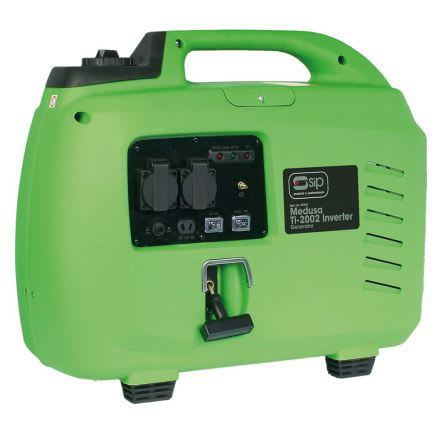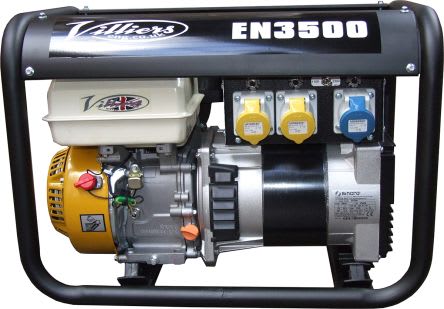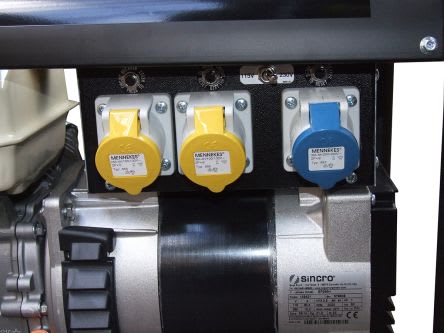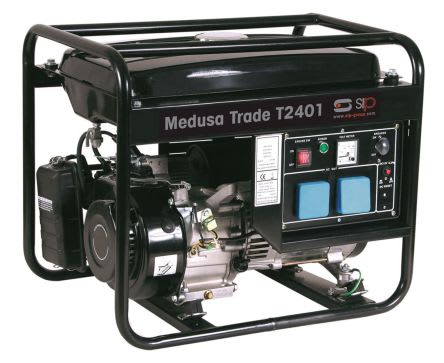- Published 5 Jan 2023
- Last Modified 29 Aug 2023
- 17 min
The Complete Guide To Portable Generators

Portable generators buying guide

Portable generators are used for providing a source of temporary, easily transportable electric power, and are very commonly found in daily operation on all manner of work and leisure sites. Common uses of a portable generator might include:
- Building and construction zones
- Home and garden use
- Camping, festivals and other outdoor activities
- Onboard electrical power for boats
- Temporary installations and pop-up shops
- General DIY and auto repair purposes
- During prolonged power cuts and outages
In this guide to choosing and buying portable generators, we’ll look at some of the many options available on today’s market in terms of machines designed to suit multiple different scenarios.
We’ll also give a brief rundown of exactly how portable electricity generators work, and what model sizes/specs you might like to consider for your intended application. Finally, we’ll tackle some basic safety tips for installing and running portable generators at home or in work.
How do portable generators work?
The best approach to understanding how portable generators work is to focus on a basic overview of the key parts involved. While a portable generator might look like a complex piece of machinery at first glance, the core components are actually fairly simple.
Moreover, although there are many different models and versions available to buy from suppliers around the UK and worldwide, the fundamentals of how they’re put together and operated are broadly very similar.
Whether you’re looking at petrol or diesel-powered portable generators, the most important parts of the machine you need to be aware of won’t often vary that much from model to model. In brief, these are:
- The internal combustion engine
- The alternator (sometimes referred to as the generator head or ‘genhead’)
- The starter
- A fuel tank
- Control devices and panels, including power outlets
- Safety/protection devices
In its most basic version, the explanation of how a portable generator works includes the following key steps:
- Fossil fuels, typically petrol or diesel, but sometimes natural gases for larger versions, are fed into the fuel tank, usually via a safety spout (it’s also possible, although often less convenient, to fill them with a funnel on some smaller models).
- After using the starter (normally a pull cord, but often a switch, especially on digital versions) to power up the generator, the liquid or gaseous fuel in the tank provides the engine with a source of combustion energy, allowing it to run for as long as the fuel source remains topped up.
- The internal combustion engine turns the built-in alternator or generator head, which converts mechanical energy (in the form of rotational motion) into electricity. This alternator is essentially constructed of a drive shaft connected to the engine, which in turn spins an electromagnet inside a coil to generate and harness an electrical field.
- This electricity is then converted to useable voltage/wattage via a regulator, and fed to the power outlets on the body of the generator. From there it can be sent via standard plugs and cables to whatever electrical devices the portable generator is hooked up to.
Depending on make, model and size, some of the other important components to be aware of in a typical portable generator might include its cooling and exhaust systems, lubrication pipelines, and the exterior housing or frame of the machine.
Types of portable generators available
As mentioned above, there are numerous portable generator types available to buy on today’s market, covering a wide range of intended use scenarios and power supply needs. In this section, we’ll outline some of the more popular options for shoppers, including models aimed at both workplace and domestic applications.

Quiet portable generators
Generators are broadly accepted to be fairly noisy machines when operating under load, although the range of portable generators available that operate at much lower noise levels has improved dramatically in recent years. A common question amongst buyers - particularly those with domestic or smaller-scale uses in mind - is always ‘what portable generator is the quietest?’.
In truth, there isn’t generally a hard and fast answer to this question; the designs and build qualities of different generator models and brands vary widely and are constantly being evolved and refined. However, certain manufacturers and models are specifically marketed as quiet portable generators for those buyers looking to prioritise reduced volume levels over raw power delivery.
There are a number of factors which influence how loud or quiet a portable generator is while running. These include:
- Engine size (and associated power output capabilities)
- Overall build quality, most crucially of the engine itself
- Whether or not the engine is running inside an enclosure
- The precise setup and build quality of the exhaust system/muffler
- Cooling method (more cost-effective air-cooled portable generators are usually a good deal louder than water-cooled versions)
- Frame/housing design and construction
Typically, the quietest portable electricity generators on today’s market will often be more expensive than cheaper but louder versions. These pricier models tend to be the inverter-type generators, which usually feature very compact designs based around a smaller but more efficient engine, which is able to produce an equivalent electrical current from smaller-scale components.
Most inverter generators will also feature a fully enclosed plastic housing lined with noise-dampening materials, making them a lot quieter to run than the traditional open-frame versions (which naturally allow far higher levels of noise vibration to escape into the surrounding environment). They’re also smaller and lighter to transport than standard models, due principally to the reduced engine size.
Additional features to look out for when shopping for a quiet portable generator include an automatic or ‘smart’ throttle: this prevents the generator’s engine from having to run at a constant speed while ever it’s powered on, as is the case with many baseline or budget models.
An automatic throttle will sense what sort of power load the portable generator is being asked to supply at any given time and step down the engine speed to match this demand. As well as allowing for much quieter operation when not under full load, this is also significantly more fuel-efficient over extended run times.
Portable generators for homes
Portable generators for the home tend mostly to be kept on hand for those occasional situations where mains electricity is unavailable for a temporary period. They’ll typically only be used during long power cuts, and might be wheeled out for that exact purpose maybe once or twice a year at most (depending on where you live, the typical local weather conditions, and what the overall condition of the neighbourhood power grid is like). There is a wide range of portable electricity generators made and sold with occasional home users in mind. Many of these will be at the lower power end of the scale and may be marketed as ‘recreational’ units, intended only for powering one or two basic appliances.
Lights, fridges and freezers are the most common targets of portable generated power in extended outage scenarios at home, followed by communications or entertainment devices such as phones, computers and TVs/radios.
A good rule of thumb when shopping for an occasional home-use generator is to calculate the total power draw of any appliances or devices you’d definitely like to be able to keep running and choose the smallest available portable generator that will meet these power needs (with a little extra headroom for safety and peace of mind).
In terms of picking out what portable generator to use for the home, bear in mind the following rough guides to average power draw from common household appliances and devices - add them up, and subtract the total from the rated power output of any portable generator units you’re considering to see if they’ll meet your needs:
- Fridge-freezer - anywhere from 150W-600W, depending on size and features
- Incandescent light bulbs - generally around 60W-100W per bulb
- LED bulbs - usually 8W-12W per bulb
- Laptop computer - 50W-200W, depending on processor power and peripherals
- Smartphone charger - usually around 5W-15W, depending on make and model
- Home air conditioner - anywhere from 1000W-4000W, depending on size
- Kettle - 1500W-2000W
- Toaster - 800W-1800W
- Hairdryer - 1500W-2500W
- Microwave - 700W-1800W, depending on size
A lot of common domestic appliances can vary significantly in terms of overall power draw depending on make, model, age, condition, and eco ratings - so it’s always sensible to check the manufacturer guidelines for any specific devices you definitely want to keep powered on before calculating what size of portable generator to buy for home use.

Portable generators for camping
When buying portable generators for camping, it pays to follow many of the basic rules of thumb set out in the section above for home use. The best approach is to work out exactly how much power you’ll need for keeping the devices and appliances you want to use on a campsite running, and then opting for the smallest machine you can find that meets all those needs with a little wattage to spare.
If you’re shopping for portable generators for caravans and motorhomes, be especially mindful of the fact that different versions and models output very different noise levels, and that not all types might be suitable for all camping environments. Bigger, louder generators may not be allowed on some campsites due to noise restrictions in place for the benefit of other guests.
As such, it’s always worth checking in advance with the owners of any specific campgrounds or caravan parks where you know you’ll want to take your portable generator, and adjusting your purchase plans accordingly.
Portable generators for boats
Many larger boats come with correspondingly large electricity generators permanently installed - but of course that’s rarely the case for smaller craft, and so there’s a thriving market in terms of smaller portable generators aimed at the owners of more modestly sized boats.
Note that portable generators themselves must never be used or filled onboard or very close to a boat, as the risk of toxic fume buildup, fire or electrocution are simply too high. We’ll cover these risks in more detail in the safety section further on in this guide.
As well as once again calculating the overall power output you’re likely to need in any given scenario while on board your craft, there are other specific considerations to bear in mind when buying a portable generator specifically for boat use. These largely revolve around available space and safe placement of the generator when not in use:
- Most boats are fairly tight on space, and so a larger generator usually isn’t a very practical option.
- As we’ll discuss in more depth in the safety section further on in this guide, you absolutely must not place a portable generator inside the cabin, below deck, or in any other enclosed space on board a boat. Due to space limitations above deck, this is usually another factor that makes purchase of a smaller and more compact unit vastly preferable.
- Fire and explosion risk must be carefully considered in terms of generator placement on boats, especially when working with combustible fuel sources.
- Similarly, wiring setups and cable runs are of critical importance when using a portable generator in any sort of environment where water ingress and potential for electrocution is a risk.
- Noise levels are also a key consideration when boating around other water users, and when moored near to other boats, people or buildings.
Portable generators safety tips
When faced with the commonly asked question ‘are portable generators safe?’, the only fair answer is both yes and no; in truth, it depends entirely on how and where they’re being used. Portable generators themselves are generally safe machines, and modern versions, in particular, include a number of safety features to increase their overall safety, user-friendliness and convenience.
Still, they’re inherently built to generate high voltages of electricity, and most types use toxic and combustible liquid fuels to power this output - so there’s clear potential for danger if they’re used carelessly or inappropriately.
Under ideal usage scenarios, generators provide a reliable and robust source of backup, portable or emergency power in a wide range of applications and environments. However, there are a number of very important rules and best practices to keep in mind if you intend to operate a portable generator safely. In this section, we’ll look at some of the key user tips to be mindful of at all times.

Portable generator placement
As mentioned in the sections above, it’s critically important never to use a portable generator in any kind of enclosed space - be it a garage, on a boat, inside a large tent, or anywhere else not directly open to the air on at least three sides of the machine.
This is because the combustion processes that power the generator usually produce toxic carbon monoxide gases, which are odourless, colourless, and very hard to detect without dedicated equipment such as a carbon monoxide alarm.
These deadly gases quickly build up during (and, importantly, for a time after) any period in which the generator is running, creating a very real threat of serious illness and even death by asphyxiation for any people or animals in the immediate area. These effects can occur within minutes of exposure, so always obey the following guidelines strictly:
- Operating a portable generator in environments such as a garage, tent or cabin - even with doors and windows fully open - presents a serious risk, and must never be considered under any circumstances.
- For similar reasons, generators must never be run outdoors in close proximity to buildings or enclosed areas into which fumes and gases can seep, and careful placement of exhausts to direct fumes away from buildings is vital.
- Always keep an active carbon monoxide alarm switched on and running in your home when using a portable generator outside the building.
- If you or anyone else in the general area begins to feel dizzy or at all unwell during or after using a portable generator, immediately stop using it and remove yourself to an outdoor location well away from the machine.
- Always check and adhere to the manufacturer’s directions regarding the safe placement of portable generators in relation to other people and buildings.
- Never take risks by underestimating the distance you need to maintain from houses, vehicles and any other enclosed structures at all times - this is never less than a minimum of 20 feet but is often more depending on the specific make and model.
- After use, always allow generators to fully cool down and residual fumes to disperse before storing them in a well-ventilated area with the tank empty.
- Never store fuels in any kind of proximity to flammable materials, or close to the generator itself.
Portable generators grounding
When using a portable generator, you must always take care to properly ground it to avoid the risk of electrocution. Many brands of generators will come already grounded, but you need to know whether or not that includes yours.
As a general rule, most portable generators won’t require additional grounding if they’re only intended to supply electricity to appliances and devices plugged directly into them and if their metal parts (fuel tank, engine and housing) are bonded directly to the generator frame. If you’re in any doubt, always refer to the manufacturer’s handbook to double-check before first use.

Specific grounding requirements may vary slightly from model to model, but in general, the process for how to ground a portable generator is fairly universal. There are many detailed guides available online which describe precisely how to do this, but you’ll always need an appropriate set of tools and equipment - at the very least, these will include:
- A copper ground rod
- Copper wire
- Wire strippers
- A mallet or sledgehammer
- Pliers
- A wrench or spanner suitable for securely connecting the grounding system to your generator
It’s a vital safety step to follow proper guidelines for meeting portable generator grounding requirements, so always consult a qualified electrician or installer if you’re at all unclear on how to do this yourself.
Improper grounding of a generator can present a significant risk of electrocution for operators and other people in the vicinity, as well as being a fire hazard in the event of a short circuit. Make sure you know exactly what the status of your unit is before proceeding with use and take the appropriate measures to fully ground the generator before powering it on if necessary.
Portable generators in the rain
Portable generators are not typically waterproof, and most models should never be run in wet, rainy or snowy conditions where it might be directly exposed to moisture during operation. Doing so can present a serious safety risk, both for the operator themselves and for anyone else in the immediate area.
If it’s essential to run a portable generator in the rain or snow, then first and foremost do not be tempted to move it to an enclosed area (see the above safety section on generator placement and carbon monoxide hazards).
Instead, use the generator outdoors as normal, but always make sure that:
- The portable generator is kept covered under an open-sided canopy-type structure or awning while in use
- No part of the canopy, be it wood, plastic, metal or tarpaulin, comes within 2-3 feet of touching the machine while operating
- The generator is placed on a raised, dry and level surface where water cannot pool or puddle beneath it
- Your hands are completely dry before touching any part of the portable generator frame, housing, panels or components, and that the surface of the generator is dry in any areas you need to be in physical contact with
- You stop using the generator immediately if it becomes wet, or if any groundwater or runoff seeps into the area you’re running it in
Portable generators overheating
Most types and models of portable generators will typically get warm during extended periods of use. This is normal, but in certain circumstances (such as very hot weather, or under extended heavy loads) a generator can overheat - this presents a safety risk to users, as well as putting the machinery at risk of serious malfunction or damage.
Always keep an eye on any temperature gauges while running a portable generator, and refer to the manufacturer’s handbook for a model-specific guide to safe operating temperatures. In many cases, issues with overheating that aren’t related to environmental conditions or excessive loads can be remedied by paying attention to a few key areas of the machine itself, including:
- Fan consistency, rotation speed and belt tension (for air-cooled versions)
- Coolant levels, and functioning coolant loops/circulation (for liquid-cooled versions)
- Excessive dirt or grease on the exterior of the engine housing
- Too much or too little fuel
- Clogged intake/output zones (especially fuel injectors and air filters/vents)
- Low oil levels
- Damaged or blocked exhausts
If your portable generator appears to be overheating and the cause isn’t immediately obvious, always avoid using it until you’ve had it assessed by a qualified maintenance professional, and repaired or replaced as necessary.